What To Plant In April
Are you ready to learn about what to plant in April? In January, I usually pick up some organic soil and worm castings to add to my grow boxes in the backyard. I highly recommend these for seedlings: CowPots and Organic Seedling Soil. This way, you plant your seeds and place the CowPots in your garden when the temperatures are correct.
My gut is telling me we must learn to grow as much of our food as soon as possible. We must be prepared for the unexpected. Growing our food is one more step to being self-reliant. This is where I buy my seeds: SeedsNow
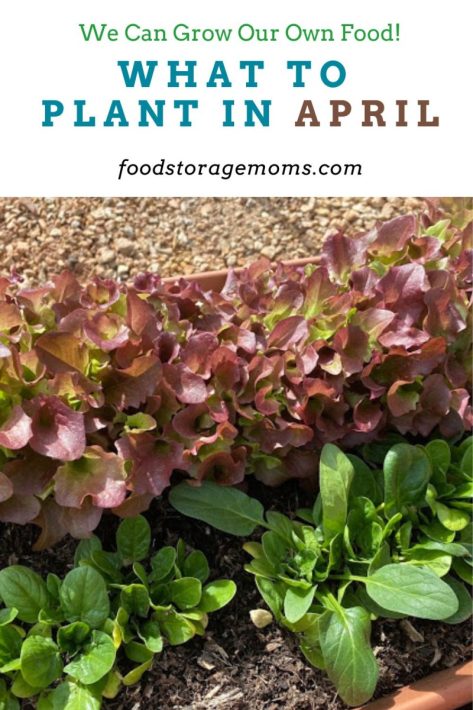
Soil Amendments
We first need to pull any weeds that have grown since the last time you turned over the soil. We must also dig out any leftover crops you missed the last time you harvested.
Turn the soil several times and add the following amendments if necessary. You may remember that I had raised garden beds in Southern Utah because I don’t want to bend down as far to work in my garden anymore.
I hope to buy raised beds this year; My gut tells me I urgently need to raise more food for my family.
Earthworm Castings Organic Fertilizer
How I store my garden seeds:
Plastic Photo Container and Label Maker
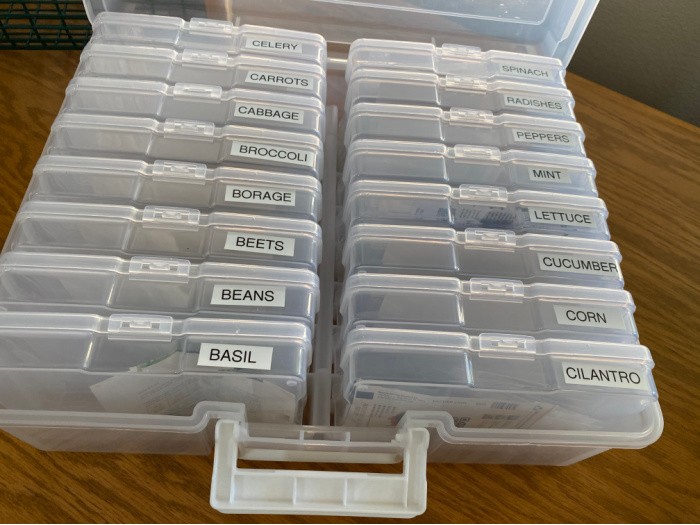
Update on Soil:
I’m so excited I found some excellent soil that I have used for three years, as of this spring. I do not have to add any amendments to it. I add two bags to each of my raised garden beds each year. (Because the soil is sinking.) I hope it is available in your area.
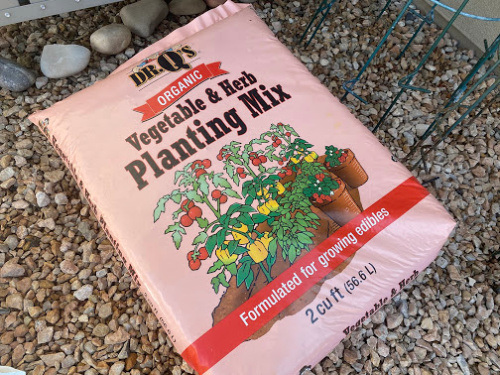
This picture shows how my raised garden beds looked after adding two new bags this year. I have to put my tomato cages in them because my puppy likes to jump up in the boxes and look around. I’m trying to break her habit. I hope I can start a garden here in Northern Utah this year.
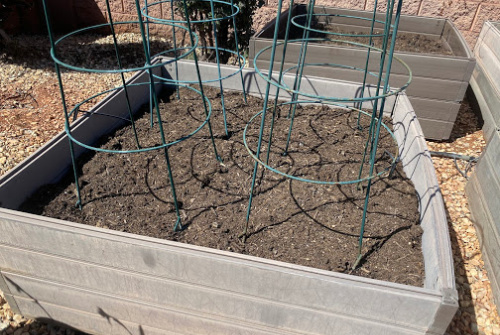
Soil pH Levels
What Does The Term pH Level Mean?
Are you wondering what the term pH level means when gardening? Each plant prefers a different level of acidity to grow the very best harvest.
Therefore, you can adjust the pH of your soil by adding lime or sulfur to bring it up or down, depending on what your soil needs. You can have your soil tested, possibly by your state extension service, or try to do it yourself with a soil tester. pH Tester
What Does The Term Harden Off Mean?
This is when you have already planted the seeds, and they have germinated and sprouted, and you have thinned out the sprouts you do not want.
Now, you need to get the plants ready to transplant outside without issues. “Hardening off” means slowly taking the seedlings outside for a few hours each day to get them used to sunlight, dry air, and cold nights.
I call it my prepping time. You start with 2-3 hours a day and gradually add more each day for 7-10 days. Do not fertilize during this time, and do not overwater either.
We are getting the plants prepped to be outside and ready to transplant. We watch the temperatures to ensure the seedlings can handle the cold weather. Every vegetable plant is different. This is where I buy my seeds: SeedsNow.
What to Plant in April by Zone
Initially, I posted what to plant in April based on where I live, but I have realized that all zones are different. What you can grow in one area may not be able to grow in another. So, I decided to break up what to plant in April by zone. Check here to find your zone.
Zone 1 and 2
It is still pretty cold in April if you live in Zones 1 and 2. However, there are still a few things you can start planting. Here’s a list:
- Cabbage
- Cauliflower
- Chives
- Lettuce
Zone 3 and 4
If you live in Zones 3 or 4, it is best to wait until after April 15th to plant many of these in your garden. Here is what you can start indoors and move outdoors when there is no longer any frost:
- Asparagus
- Beets
- Broccoli
- Brussel Sprouts
- Cabbage
- Carrots
- Cauliflower
- Kale
- Lettuce
- Onions
- Parsley
- Peas
- Potatoes
- Radishes
Zone 5 and 6
April is the perfect time to start planting in Zones 5 and 6. Here’s what you can begin planting:
- Asparagus
- Beets
- Broccoli
- Cilantro
- Cabbage
- Carrots
- Lettuce
- Peas
- Spinach
- Strawberries
Zone 7 and 8
It is pretty warm in Zones 7 and 8 during April. Here are the things you may want to start planting:
- Bush Beans
- Poles Beans
- Cantelope
- Corn
- Cucumbers
- Eggplant
- Peas
- Peppers
- Okra
- All warm-season herbs
- Squash
- Sweet potatoes
- Tomatoes
- Watermelons
Zone 9 and 10
April is like summer in Zones 9 and 10. So, you will want to plant warm-weather plants. Here’s what to plant:
- Bush Beans
- Pole Beans
- Cantaloupes
- Corn
- Cucumbers
- Varieties of peas
- Peppers
- Pumpkins
- Summer squash
- Tomato transplants
- Sweet potatoes
- Watermelons
What To Plant In April
1. Asparagus
Asparagus is one vegetable for which you must realize that it takes 2 to 3 years for the plants to start producing. It’s worth the wait, I promise.
These are perennial, meaning they will return year after year once established. The plants will grow year after year, sometimes even up to 30 years.
It would be best if you decided how much your family likes asparagus. We purchased 20 plants, 10 for each of us. It’s all about how much you want to produce.
My suggestion is to plant at least ten plants per person in the household. Once they get established, you will have asparagus for life. You can eat it raw, cook it, and even freeze it.
Asparagus likes a cool winter to go dormant and grow strong for spring. You will have better luck with colder winters than with mild winters. It makes the stocks stronger.
They like well-drained soil with a lot of organic matter. Plant the plants two inches deeper than the original growth mark and at least 6-8 inches deep, running the length of the row.
Space the plants 12 to 18 inches apart. After planting them, be sure to water the soil around them. As they grow, keep fertilizing them with Miracle Grow All Purpose liquid or granules.
After the first frost, cut back the 4-foot foliage or ferns when they turn brown from the freezing temperatures in the fall. Watch for weeds around them and remove the weeds.
The younger the stalks, the shorter the production time. Older asparagus will produce up to eight weeks. Snap the shoots when they are about 8 inches tall at the baseline of the soil.
I prefer my spears to be the size of a pencil. They are more tender when picked this size. Be careful not to “bruise” other stalks by cutting them with a knife. SeedsNow
pH level for Asparagus: 6.0-8.0
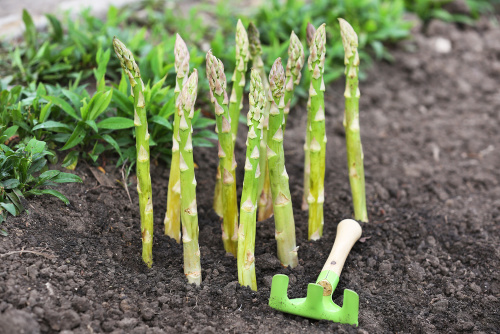
2. Basil
Plant the seeds 1/2 inch deep and 12 inches apart. The seeds will germinate in about 5-10 days and they need the soil temperature to be 65-85 degrees. (With nights above 55 degrees) Plant the seeds in full sun to get the best harvest.
Once the plants reach six inches tall, start cutting them back so they will branch out and have stronger stems.
They need well-drained soil. Fertilize them with Miracle Grow All Purpose Liquid or granules and water them in. Water often, but don’t overwater.
Some people like to plant different varieties of basil together. Once you see those white flowers, cut back the basil significantly. It will come back, I promise, if the weather is still good.
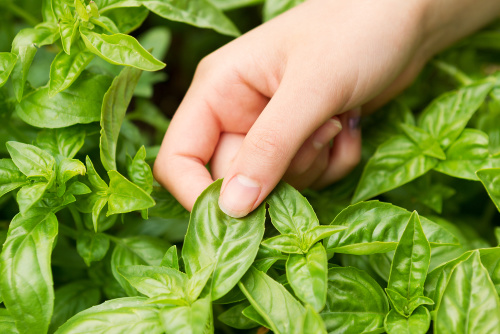
pH level for Basil: 6.0 -7.0
3. Cauliflower
Cauliflower is a cool-season crop. However, it’s a bit more temperamental than broccoli. The trick is to consistently have cool temperatures to produce crops with larger heads like those in coastal neighborhoods.
Cauliflower likes temperatures around 60 degrees. If the temperatures get too hot or cold, it stresses the plants and produces tiny buds.
Plant the seeds about 18 inches apart with rows 30 inches wide. Cover the seeds with soil and compost. Water the seeds gently.
When the cauliflower heads are about two inches in diameter, cover them with their leaves, if possible, to shade and protect them. Ideally, the head will grow to 6-7 inches in diameter.
pH level for Cauliflower: 5.5 – 7.5
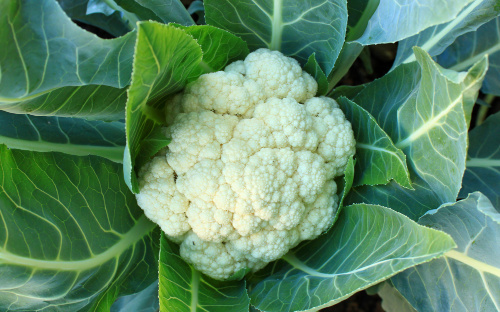
4. Celery
Because celery seeds are so tiny, you may want to mix them with sand before sprinkling them over the loamy, well-drained soil described above with added nutrients.
Before planting the seeds, the temperatures must be at least 50 degrees F. (10 C). Cover the seeds with soil and sprinkle them with water.
They like to be planted shallowly. Once you see some sprouts, you will want to thin them. They will not tolerate a drought at all.
They need a lot of water, so keep that in mind when deciding where you plant them. Please fertilize regularly to have the best harvest.
pH level for Celery: 5.8 -7.0
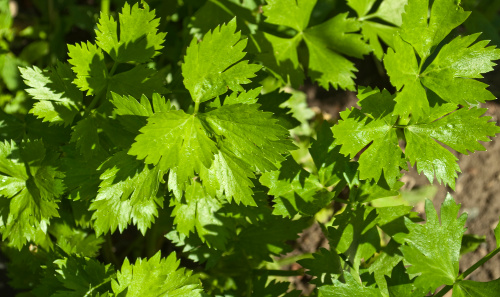
5. Eggplant
Start the seeds indoors for about 4-6 weeks before transplanting them outside. Plant the seeds 1/4 inch deep in Organic s
Prepare the soil outside to transplant the seedlings with a 5-10-5 fertilizer spread with 1 inch of well-rotted manure. Transplant the seedlings when they are 3-4 inches tall and space them 24-30 inches apart in the garden beds you have prepared for them.
Cover the base of the seedlings with a good mulch to protect the plants.
Stake the plants right away because the eggplants get heavy very quickly. I have used tomato cages that work great, but mine are heavy-duty and will not tip over.
After planting, water them well and fertilize them every two weeks. Watch for the number of eggplants growing. Thin the eggplants to five or six per plant to have the best harvest. Eggplants take 100-120 days to reach maturity from seed to plant.
Eggplants prefer warm weather over cool weather. They prefer the soil to be 70-90 degrees F. to germinate. They need one inch of water per week.
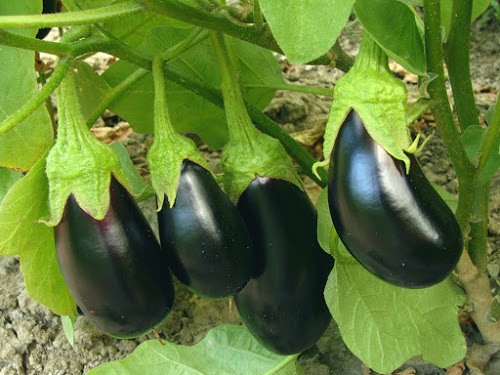
pH level for Eggplant: 6.3 – 6.8
6. Melons (last two weeks of April)
Melons are easy to grow with sunshine, warm weather, and amended soil with well-rotted manure and organic compost.
The soil temperature has to be above 70 degrees to germinate the seeds. I typically plant three seeds about 1 inch deep in each hole and space them 36 inches apart to allow for growth.
Once the seeds grow to 3-4 inches, I choose between the three sprouted seeds and discard the weakest one, leaving two standing sprouts.
Melons need water because they are mostly water, so never let them dry out. Be careful with the foliage, as that’s where the sweetness comes from.
Keep the garden weeded so you can watch the fruit when it starts to grow. To test if the fruit is ripe, carefully lift and twist it; it will easily slip off the stem if it is ripe. SeedsNow
Late melons do not slip off the stem when ripe. Honeydews are ready to pick when the area where the melon rests on the ground turns from yellow to white.
Hales Best Cantaloupe: Day to maturity 85-100 days
Honey Rock Cantaloupe: Day to maturity 85-100 days
All Sweet Watermelon: Day to maturity 90 days
Sugar Baby Watermelon: Day to maturity 75 days
Tom Watson Watermelon: Day to maturity 85 days
Crimson Sweet Watermelon: Day to maturity 85 days
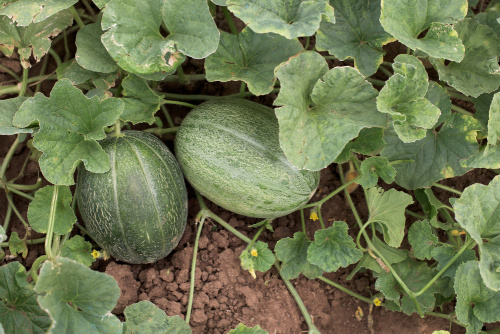
pH level for Melons: 6.0 – 6.5
7. Oregano
Oregano can be grown in the ground or in pots. It’s a perennial so that it will come back year after year. However, you must keep it under control, as it will take over the garden, so cut it back as needed.
Once dried, it’s stronger in flavor than when freshly picked. Sow your seeds indoors for about 4-6 weeks before you plant the seedlings outside. Use good potting soil and cover the seeds with a bit of soil. They will germinate very quickly.
Ensure the soil temperature is 70 degrees before transplanting them outside. Plant the seedlings at least eight to ten inches apart.
They will grow very well in light soil and with very little fertilizer. As companion plants, they do well around tomatoes and peppers. Water only when the soil is dry to the touch.
I let mine grow to eight inches tall and harvest the leaves before they flower. The leaves dehydrate very well.
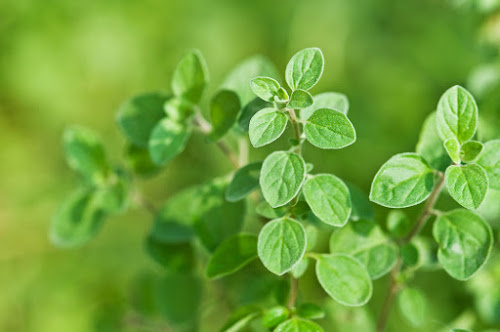
pH level for Oregano: 6.5 – 7.0
8. Peppers
Start your sweet peppers inside about 8-10 weeks before your neighborhood’s last spring frost date. I typically put three to four seeds in each seedling container and thin them down to two plants once they are about 4 inches tall.
I use Miracle Grow Organic Potting Soil, which works excellently when planting my seeds. I plant them 1/4 inch deep, cover them with soil, and water them.
You are ready to transplant once the soil temperature stays above 65 degrees. Be sure to “harden off” the seedlings ( as discussed above) about ten days before the transplant.
Fertilize the soil before planting the seedlings. Plant the seedlings about 18 inches apart. Sweet peppers require water and do not like the soil to dry out from the heat. They need to be watered as needed.
Canary Bell matures in approx. 100 days
Big Red matures in approx. 75 days
Coral Bell matures in approx. 88 days
California Wonder matures in approx. 75 days
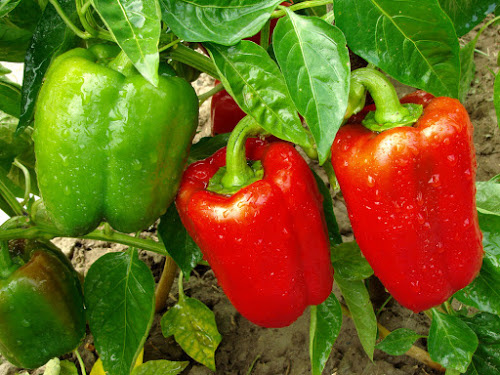
pH level for Peppers: 5.5 – 7.0
9. Rosemary
Rosemary is a great herb, but growing from seeds is more challenging than growing other herbs. Rosemary seeds are best started indoors and transplanted.
Plant several seeds in one container with potting soil because they may not all germinate. Cover the seeds with a thin layer of soil and gently water the seeds.
Once the seeds start to sprout, you need to thin them if necessary. Do not overwater; rosemary doesn’t like a lot of water.
The soil must be warm outside to transplant the seedlings. It must be 80-90 degrees F before you can move them outdoors.
It’s a woody perennial that will not be ready for harvesting the first year. Some people buy the plants rather than seeds at their local nursery.
Where I live in Southern Utah, it takes over the yard. You have to keep cutting back, or you will have a shrub that is three feet or more in diameter.
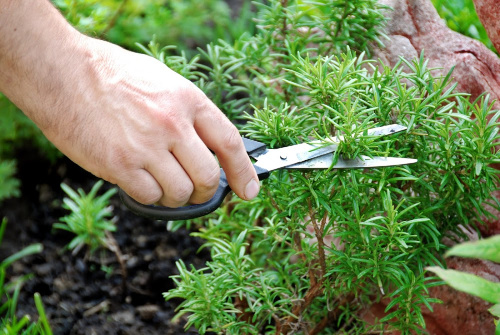
pH level for Rosemary: 5.5 – 6.0
10. Sage
Sage thrives in sandy, loamy, and well-drained soil. It does not need to be fertilized often; it’s a pretty easy herb to grow without much fuss.
Plant the seeds in good potting soil and transplant them to a location with full sun and well-drained soil. Transplant the seedlings when the soil temperature is 60-70 degrees F.
Plants will grow from 12 inches to 30 inches in height.
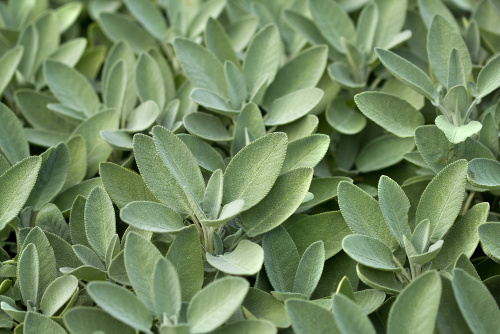
pH level for Sage: 5.5 – 6.5
11. Thyme
Thyme is a perennial shrub with light branches and small purple-pink flowers. Growing thyme from seeds is a little more complicated, but not impossible. You must be patient in germinating the seeds, so plant more than you expect to transplant outside.
It would be best to plant the seeds indoors 8-10 weeks before the last spring frost in well-drained soil. The soil needs to be 70 degrees F before transplanting the seedlings. The plants will grow from 6-12 inches in height.
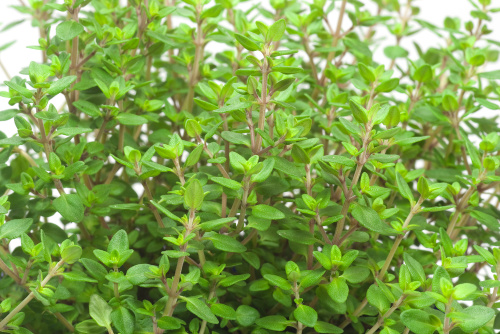
pH level for Thyme: 5.5 – 7.0
12. Tomatoes
Let’s discuss tomato choices. You must decide whether to eat BLTs—that’s awesome! You must also consider which tomatoes are best for making salsa, juice, or spaghetti sauce.
Of course, these have to be suitable for your area. I only know Utah, so I will share what I have done for years. These are 100% Heirloom/Non-Hybrid/non-GMO tomatoes. I buy all my seeds from SeedsNow
- Abraham Lincoln: 1 lb. heirloom, great for ketchup and tomato juice. Easy to grow and matures in 85 days.
- Beefsteak: These large tomatoes, over 2 lbs, are easy to grow, incredible for slicers, and mature in 85 days.
- Bonnie’s Best: 6-8 ounce fruit, great for slicers or canning. Matures in 85 days.
- Marion: Chefs prefer these crack-resistant tomatoes. Great for salads or sandwiches. Matures in 75 days.
- Pear: Pears grow in clusters. Great for salads. Matures in 75 days.
- Homestead Variety is a popular heirloom variety. It is suitable for canning and thrives in a hot climate. It matures in 80 days.
- Mortgage Lifter: These produce large tomatoes, up to 2 lbs. They are easy to grow and mature in 70 days.
- Money Maker: It’s one of the most reliable tomatoes you can grow. It grows up to 8-ounce tomatoes, is easy to grow, and matures in 85 days.
Best Time To Plant
The best time to plant your seeds indoors is about 6-8 weeks before the last expected spring frost in your neighborhood. You can grow your seedlings or plants about two weeks after the last spring frost.
You can enter your zip code on this website to find the best start dates. Farmer’s Almanac First and Last Frost Dates By Location
Growing tomatoes from seeds is easy. You can start with seed pellets or transplant them to larger containers.
The seeds do not need light, so you can put them on top of your refrigerator to keep them warm to germinate. As soon as the seedlings pop up they need sunshine.
You can put them on a window shelf or a table close to the window. You should see them poke through the soil in 7-10 days. I purchase seed pellets from SeedsNow.
The seedlings need the temperatures to be 70 degrees F during the day and at least 40 degrees F at night. Once the seedlings reach 4 inches tall, they are transplanted into larger containers. Please plant them in more profound containers than other vegetables.
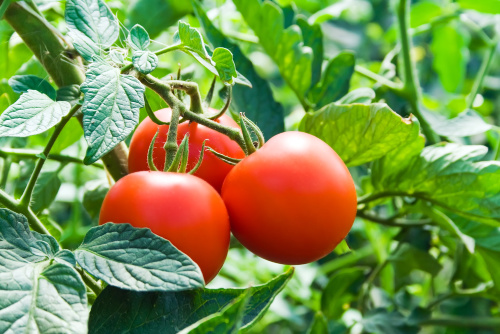
pH level for Tomatoes: 6.0 – 6.8
Please Check Out What To Plant Each Month:
- What To Plant In January
- What To Plant In February
- What To Plant In March
- What To Plant In April
- What To Plant In May
- What To Plant In June
- What To Plant In July
- What To Plant In August
- What To Plant In September
- What To Plant In October
Final Word
I hope you enjoyed my post on the 12 vegetable seeds you should plant in April. It’s all about being self-reliant, right? If you have a Farmer’s Market close to you, that is awesome! Check them out for very fresh fruits and vegetables.
If you have a lot of acreage, you rock! I have a very small with fair soil. It’s not fun, but I’m determined to grow most of our food. Please be prepared for the unexpected. May God bless this world. Linda
Copyright Images: Asparagus Being Planted Depositphotos_74502399_XL by Belchonock, Basil With Hand Picking Depositphotos_49776517_XL by tab62, Cauliflower Depositphotos_32133759_XL By SlavicaPopovska, Celery Depositphotos_3814864_XL By ksena32, Eggplant Depositphotos_13640174_XL by DLeonis, Two Melons Depositphotos_138051762_XL by tchara, Rosemary Seasoning Depositphotos_5766087_XL By simply, Fresh Tomatoes Depositphotos_1342563_XL By lmeleca, Thyme Depositphotos_3704808_XL BY saphira, Sage Plant Depositphotos_32692027_XL by siyue, Bell Peppers Depositphotos_12462571_XL By DLeonis,

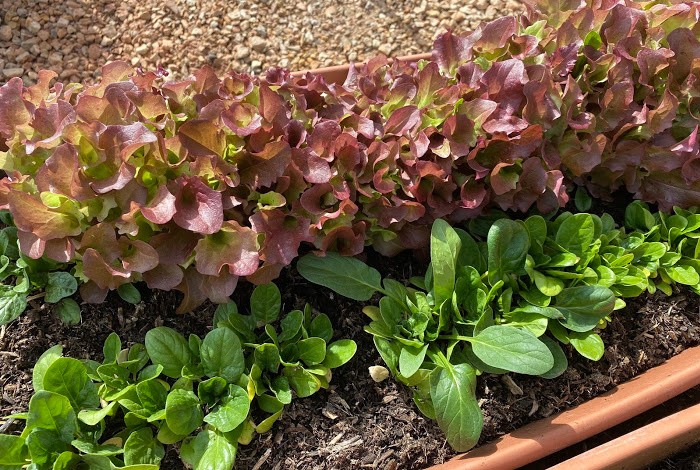

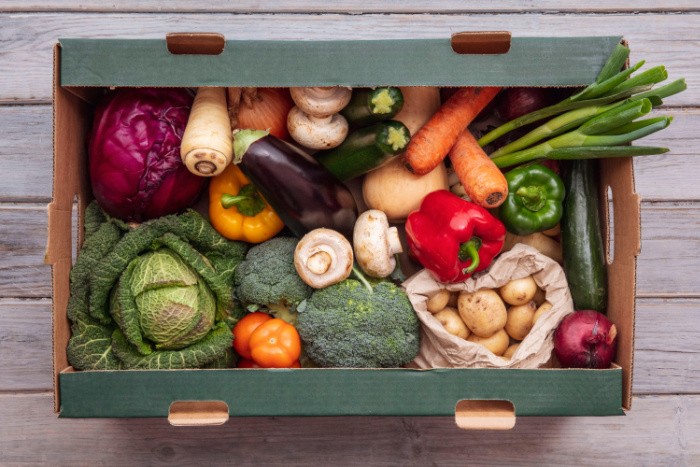
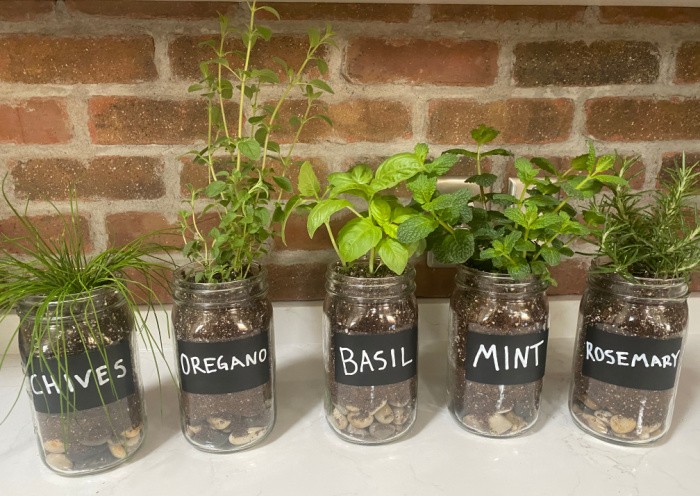
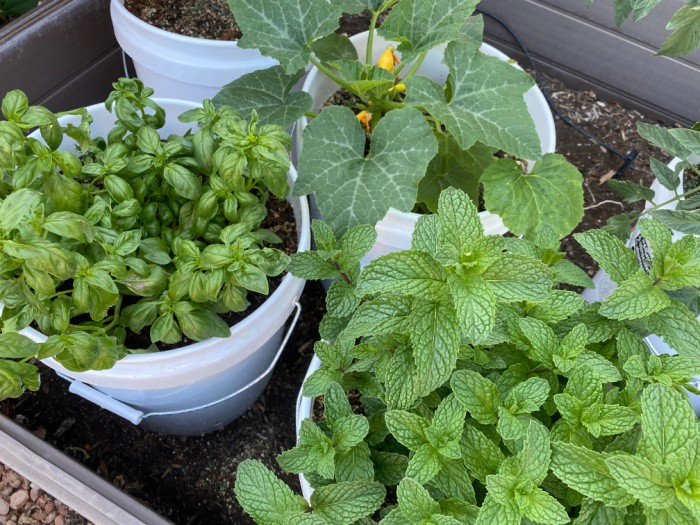
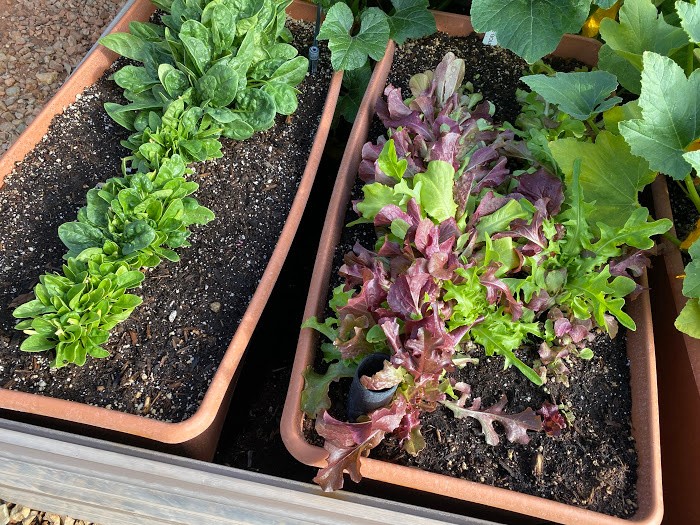
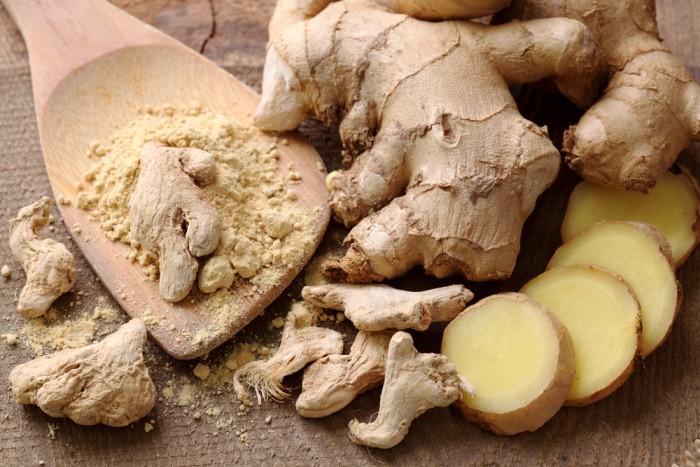
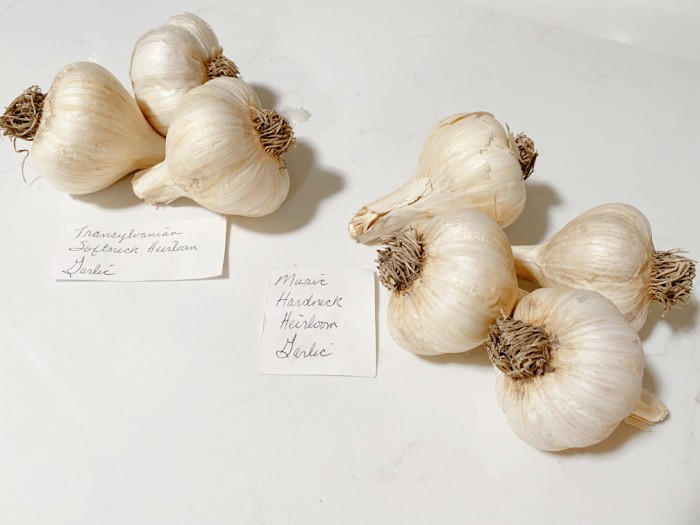













I had to laugh at your “puppy protector”: I did the very same thing the other day when my German Shepherd stepped in my pea bed going after a lizard!
Hi Roxanne, oh, the pea bed and the lizard, oh my gosh! I have to laugh, it’s funny but it’s not funny!!! LOL! Linda
how do I find out what zone I live in
HI Angela, I have a link in the post so you can add your zip code. I tried to put the link here but it didn’t work. Please go back to the post, I will put it one more place. Linda
You mentioned planting at certain times. I was brought up by people who went by the Almanac but also
by legends. I was told you planted Potatoes by March 17 no later.
Also if you plant your tomatoes now ( I got to buy my plants) just watch the weather and if it gets
to cold just cover them. You can take a gallon milk jug, cut off the bottom and place over the plants.
In the day IF you won’t them to have air before it gets warm take the lid off. then when it warms up
uncover them.
My mom always told me and I believe this that when you have a garden you will never go
hungry. You might not eat what you want to want but you will never go hungry.
Sometimes with this virus going around and people talk about how bad people are for hoarding
things. I feel like they are talking about us, then I remember NO I have had these things for a while now not like the people who go in and buy 10 jumbo packs of Toilet paper and fill their carts with
meat and things. We all have to remember we have done this for years not a few days.
Did anyone try my cucumber spread? Did you like it?
Hi June, I need to make that cucumber spread, thanks for reminding me. We have been prepared for years, that’s how we roll, June! I love the statement “If you have a garden you will never go hungry.” I love it! Linda
I have never had any luck planting before the last frost. The seeds don’t germinate in the cold soil so why do you say you can plant in April in zone 6? Am I doing something wrong?
Hi Nancy, I’m trying to see where you read planting before the last frost. I always recommend checking the temperature of the soil before planting outside. Am I missing something? The weather is so unpredictable every year. If it’s too cold the seeds will not germinate so we start the seeds inside our home. I hope this makes sense. Linda
Hi due to covid 19. I’m home and can actually plant in my raised bed garden. I cannot do seeds as it is to late. Where can I order plants and when should I plant them? I had put mushroom soil in my garden a few years back , what should I put in there to get it ready? I’m in south NJ zone 7 , last frost was April 21st last year . I would like to have planted some lettuce, string beans, peppers and eggplant . Also herbs. Any suggestions would be great. Thanks
Hi Jenn, you would need to check the ph level in your soil. It’s not too late to plant lettuce, there are so many varieties. I’m in Zone 8 and just planted green beans yesterday. If your soil is okay you can still plant. You may have to order the soil amendments I described in my post. It’s only April you can plant a lot of stuff. Hopefully, you have seeds. Please read all my posts on gardening. You can do this, Linda
Hi thanks for the info, I don’t have the Dr Q’S soil but I do have Dr earth raised bed soil for plants / veggies and herbs. Or miracle gro of the same nature. My local specialty harden center has some plants like lettuce spinach etc. should I be only planting seeds now or when do I plant the nursery starter pants you can buy. I would like to do cukes eggplant zucchini , red and orange peppers and string beans . Lettuce and spinach as Well. I can buy starter pants if lettuce spinach . Plant seed for the rest ? I have also heard a lot about fertilizer ? How much and when ? Thanks so much for your help.
Hi Jenn, great choice on your soil. I only use Miracle Grow plant food. I dilute according to direction on the container and water it in. Super easy. Linda
So I just want to make sure its not to late to plant seeds outside ? And I can also use the. Small starter lettuce plants as well from nursery and plant ? If I decide to use plants from nursery how do you know when to plant those? Thanks
Hi Jenn, it depends on your zone. I doubt that it’s too late, it’s only April 2nd. It would depend on the seeds. I suggest you follow my posts on gardening. I have a post for every month (with zones 1-10) You need to go to the USDA Zone and put in your zip code. Get your soil prepped and put your gloves on and start planting according to my planting instructions. I have posts on just about every vegetable. You can do it and have fun while you plant! Linda
I am going to get seeds but noticed for beans and cucumbers and spinach there are a million varieties . I love sting beans but don’t know which seeds to get ? They say pole or bush beans ? As for cucumbers and spinach I just want the type you get at the market? What would they be called ? Do you know which seed packets I should get ?
Hi Jenn, here again, it all depends on the amount of space you have to plant. I prefer Bush Green Beans and Bush Cucumbers because they are smaller shorter plants and produce enough for my needs. Some people like to use trellis forms, I do not have enough room for those. I would go to SeedsNow (where I buy my seeds) or go to your local nursery and read the packages. Please look for Heirloom seeds so you can “save the seeds” to plant next year.
Hi again , I’m purchasing a soaker hose system and am getting ready to plant . I have a 5 by 8 foot raised bed garden. How far apart am I planting the veggies . There are so Many different opinions . Some say do square foot gardening , I wouldn’t be able to plant anything, others say plant close because it’s a raised bed garden. Also I can’t find the potatoes for planting. Is there another way for potatoes . Our last frost was mid May last year. Thanks.
Hi Jennifer, I was not able to get potatoes this year, but my organic Non-GMO potatoes are peeking up through my pots already. They were stragglers I missed last year. It’s fine because I will always have potatoes if I buy organic Non-GMO potato seeds. You typically have to get your name on the list so the seed company can ship the seed potatoes when your zone is safe to plant. Check with a local farmer or neighbor or wait until next year. I have seven 4 by 4 foot raised gardens. You will plant the seeds according to how far apart they need to be and how deep to plant the seeds. There are some plants you can plant together and others do not work. Please read your seed packets or read my posts on What To Plant In January through October. Here is May: https://www.foodstoragemoms.com/what-to-plant-in-may/ You can do it, you will learn something each year. Linda
Hi Linda, thanks for another great post! My gut is also talking to me, & it’s saying to grow as much food as possible this year. Our food supply chain is a mess & it feels as though it’s going to get a lot worse. (Hope I’m wrong about that.)
In addition to our regular garden, we’re doing edible landscaping this year. We’re planting in the ground, in bushel baskets (sweet potatoes look beautiful in these!) and hanging baskets.
And although they won’t produce this year, we’re adding more fruit trees & berry bushes.
God bless us all.
Hi Amy, oh my gosh, I bet those sweet potatoes look beautiful in those bushel baskets!! I love this idea! I hope I’m wrong but I agree, I’m worried about our food chain as well. I love hearing how you are planting frit trees and berry bushes. Good job, Linda
Linda, this year I was finally able to add 20 pound bags of worm castings to each of my raised bed gardens. By next year I should have enough of my own vermicultured worm castings to do the job. I’m also using Doctor Q’s Vegetable and Herb planting mix, along with my regular compost to bring my gardens up to the proper soil level. Where I live in AZ the natural soils are so poor I’ve had to prioritize making my own soil–and now, finally, I’m trying to make that process sustainable.
As usual I enjoyed your “What to Plant” article. Depending on who you believe I’m either in Zone 8b or 9a, and my “average last frost date” is March 15. Most years I’ve planted my tomato seedlings outside by now, but this year it’s been much colder than normal–we’re still getting down into the 30’s at night. So I won’t be putting my tomatoes out until it warms up a bit (probably next week). My wife’s favorite tomatoes are Sweet 100 cherry tomatoes. I always disliked planting them because they were hybrids, but this year I found they’d been de-hybridized and made open pollinated so I’m trying them out. They are called Peacevine Cherry tomatoes and if they really do taste the same as the Sweet 100’s they’ll be on my plant them every year list because those tomatoes are delicious.
I’m trying a new musk melon variety this year called Collective Farm Woman Melon and as you might have guessed it’s a Siberian variety that should set fruit before the harsh heat of our AZ summer.
Hi Ray, oh my gosh, I need to try the Peacevine cherry tomatoes! The Sweet 100 are delicious but I couldn’t keep up on the picking of them. I’m planting my tomatoes today. I will cover them if the weather gets too low. I can hardly wait to pick that first tomato! Thanks for the tip on the Peacevine Cherry, I’m going to head to the nursery and see if I can get one. I love new ideas! Linda
Linda, I got my Peacevine tomato seeds from High Mowing Seeds (an Oregon outfit) but Terrior Seeds in Prescott, AZ may have them also.
Hi Ray, thank you, my friend, I will order some today. I love it! Linda
I have 2 large plants of Rosemary. They bloom on early Spring here and keep deer away from the roses in my yard. I love the smell and the small flowers! My plants are about 3 ft. across. I trim them after bloom, but because they are drought -tolerant , they don’t need much water here once established. They grow all over the hills in Israel, especially on the Mt. of Olives. the plants are much smaller there than mine get, but they still smell wonderful.
Hi Cheryl, they really do smell good! I used to have some and they took over a section near my driveway. I had them torn out, it was too much work to keep the black widows out of them. Tarantulas love hiding in holes under them too. I saw way too of those critters. So I keep a small bush trimmed way back!! Linda
Yes, I totally understand about the black widows. We lived in NV for 3 years and had them all over in the rock area outside our front door. Our girls would neve go out that way for that reason . They went out the back door instead. the one that scared me the most was when I was training my 2-yr old and went into check his little seat before I put him on it and found a black widow and her web right under where he would’ve been sitting! Scared me to death! It was just before we moved away to WA, I used a lot of spider killer in NV. We were happy to get out out of there and tp be able to grow something besides spiders and tumble weeds!!
Hi Cheryl, oh my gosh, that is scary! I don’t have black widows, here but our neighbors do. I have a group spray my house once a month. I still look for the junky webs just in case. I can’t imagine finding one on a toddler’s potty chair!! OH MY GOSH! So now you grow other stuff, I LOVE it! Oh, the tumbleweeds are bad too! The rocks bring cockroaches here. Lovely, LOL! It’s not fun when you have neighbors who do not spray. The bacteria those critters bring, I can’t even think about it. LOL! Linda
Linda,
One quick tip about growing melons. Do not water them the week before you plan to pick them, or if they start to wilt just give them enough to prevent wilting. Not watering them concentrates the sugars and makes them sweeter. Watering, especially over watering, will dilute the flavor. The flavor of last year’s melons in my garden was ruined by unexpected rainfall.
Hi Ray, thank you for the tip on the melons. That’s a bummer about the watermelon!! Fingers crossed for this year! Linda
Linda,
As always I love your “What to Plant” articles. Question–does that pH tester really work? I’ve never had good luck with any probe type pH tester so I rely on chemical testing using white vinegar and baking soda.
It’s been so unseasonable cold here in my part of zone 8 that my asparagus just put in an appearance 3 days ago (April 3). Normally it’s up and thriving in Feb or early March, and two years ago it came up in January. Peas are doing well as are beets, carrots and chard. My new crop of Bok Choi is up, but neither my Early Jersey Wakefield, Red Acre, nor Aubervillier Savoy cabbages have come up yet (and I planted them on March 16). This has been one weird Late Winter/Early Spring season so far. Even growing seedlings under my grow light set up has been affected by the cold. Took my tomatoes a month to germinate and just today (4/7) the last of my peppers came up. Since you said you might be planting tomatoes this year I highly recommend Mortgage Lifter and Gardener’s Delight. Both have superb flavor and both are heirlooms.
Normally, by this time I’d have potatoes up and growing, also green beans, but not this year. I’m still planning on starting my 3 Sisters planting with Butterfruit Corn later this month. Then I’ll follow it with Monte Gusto or Seychelles pole beans and either Hopi Pale Gray or Borchart’s squash.
The Butterfruit corn works well here because it has thick, five foot stalks to better withstand our high winds. It’s a SuperSweet variety that retains its sweetness up to two weeks longer than most other corn varieties. I got it from Park Seed, but have discovered it’s cheaper elsewhere. It’s one of the very few hybrids I grow.
Monte Gusto pole beans are a yellow bean with simply amazing flavor. The Seychelles not only taste great, but they are very straight and are the best bean for canning I’ve ever grown. Both of these beans are from seeds I saved in prior years.
The Hopi Pale Gray is a drought proof squash that produces very tasty fruits, that hold practically forever after being harvested (mine were still good after seven months in storage). The Borcharts squash is new to me this year, but it comes recommended by Jackie Clay Atkinson (Seed Treasures) and is supposed to be sweet enough to make pumpkin pie with.
Hi Ray, You know I love hearing what you are planting. If we can grow anything this year I will email you for sure. A guy (Master Gardner) in St.George Utah came over and showed me how to use one of the pH testers. Please share your white vinegar and soda technique, that’s cheap! Thanks, Ray! Linda
Linda,
Maybe you could do an article on the right way to use one of those electronic soil testers, as I’ve never figured it out.
Hi Ray, that’s a great idea. I hope I have some soil to test this year! They start excavation on Monday. Last Monday, we had too much snow. Linda
Hi Ray, I forgot to add, I’m with you as far as the weather and temperatures. I think the whole “When to Plant Zone” has totally changed. Linda
Linda, the following info on using vinegar and baking soda is copied mostly verbatim from the latest edition of my book, “Bugging In: What To Do When TSHTF and You Live in Suburbia.”
Building good soil is one vitally important skill to learn if you plan on growing your own vegetables and fruits sustainably.
Before you can improve your existing soil you need to learn what it lacks and what it has too much of. The first step is to determine the pH level. Most vegetables prefer slightly acidic soil, meaning a pH between 6.3 and 6.8. Proper pH is important because if it is out of whack your veggies will not be able to absorb the minerals they need for good growth and production. For Example: Tomatoes need calcium to prevent things like Blossom End Rot. No matter how much calcium (l use crushed and powdered egg shells) you amend your soil with if the pH isn’t 6.8 or below your tomatoes can’t fully utilize it.
To test your pH level, dig up a few cups of soil from a few different places in your garden bed. Don’t’ just skim the surface, go down to where roots will grow. Okay, skimming the surface is fine for one of the cups, since you need to know the pH of that top most layer, but go down deeper for the others. Anyhow, dig up a few cups and set half of them aside.
Pour a half cup of distilled white vinegar into half of the cups of soil. If it fizzes you have alkaline soil, meaning a pH above 7.0 (neutral), so you’ll need to amend it with things like sulfur, peat moss, sawdust, compost, leaves, small or shredded bark chips, or pine needles. As a rule, the more organic material you have in your soil the better. Organic material improves fertility and acts as a buffer to keep your soil from getting either too acidic or alkaline.
If you have sandy soil you can mix in 1 pound of sulfur per 100 square feet. For Clay soil use 2 pounds per 100 square feet, and for loamy soil apply 1 ½ pounds per hundred square feet. The best time to do this is in late Fall after you’re done harvesting.
If it doesn’t fizz, pour some distilled water into the half of the cups you haven’t tested yet–just enough to make it into a thick mud. Take two teaspoons of the mud and mix it with half a cup of baking soda. If that mixture fizzes your soil is acidic. Depending upon the strength of the reaction the pH could be anywhere from 5.0 to 6.6, but in any event it’s below 7.0, which is usually a good thing.
But, like being too alkaline, too much acidity is also a negative. Adding agricultural lime to such acidic soil will increase its alkalinity by adding manganese. Just don’t do this right before growing season. Do It in the Fall, after your final harvest. Agricultural lime takes months to break down and improve pH. Wood ash from your wood burning stove will raise the pH more quickly. The amount you need to add to raise your soil’s pH varies depending on whether your soil is sandy (4 pounds of lime for every 100 sq. feet), clayey (10 pounds per 100 sq. feet) or loamy (8 pounds per 100 sq. feet).
If neither of your tests result in fizzing it means you have soil with a neutral pH of 7.0, or close to it. While most veggies will grow in neutral pH soil, you should still amend it to make it more acidic.
Okay, now you know how to test for pH if you don’t have a pH test kit, which is good to know since those things may not always be available. Oh, and as for electronic soil testers I’ve never found one that I considered accurate—and most didn’t work at all. (Of course I tried some. I like gadgets as much as any guy).
Hi Ray, oh thank you for the information on how to test our soil. This is awesome it’s in your updated book. I love this, thank you, Linda
Linda,
Your “What to Plant in” articles are always among my favorites. Love the tip on mixing celery seeds with sand as I’ve always had problems getting celery to germinate. I started mine inside this year and that has worked well as it was simply planted in vermiculite.
Today I’m planting more potatoes (Red Norkotah and Carola Russets) and interplanting them with Contender or Dragon Tongue bush beans, Detroit Dark Red Beets and Marigolds.
I’ve mentioned previously that I’m also growing Clancy potatoes from seed this year. Of particular note to Preppers, potato seeds can be stored for up to three years and retain viability. So get some and store them.
I’ve become a fan of companion planting in recent years. Last year and this year again I put tomatoes and marigolds in with my Asparagus. Asparagus repels nematodes that attack tomatoes, tomatoes repel asparagus beetles and marigolds attract pollinators for the tomatoes.
Tonight’s dinner is shrimp fried rice and aside from the shrimp, rice and water chestnuts the other ingredients (onion, garlic, bok choi, carrots, broccoli, and snow peas) come from our garden. The eggs come from our hens. And by the way, bok choi stems are a decent substitute for celery or water chestnuts if you don’t have them. I say this not to brag, but because the more you can eat from your own garden the more prepared you are.
HI Ray, I never view your comment as bragging, it actually shows all of us what can be done even in a desert garden. That dinner sounds so good and man does it taste better with veggies from your own garden! I never though about boc choi stems as a substitute for celery! I love this! Linda
Linda,
I posted the wrong seed potato varieties I planted this year. This year is Canela Russet potatoes and Red Pontiac potatoes. Last year was Carola and Red Norkotah.
The Clancy potatoes I’m growing from seed are still too small to put out, but another week or two and they’ll be ready to plant also.
Hi Ray, good to know, when and if I get a garden set up, I will email you for the ones you prefer. I only had good luck with Yukon Gold in Southern Utah. You’re the best, Linda